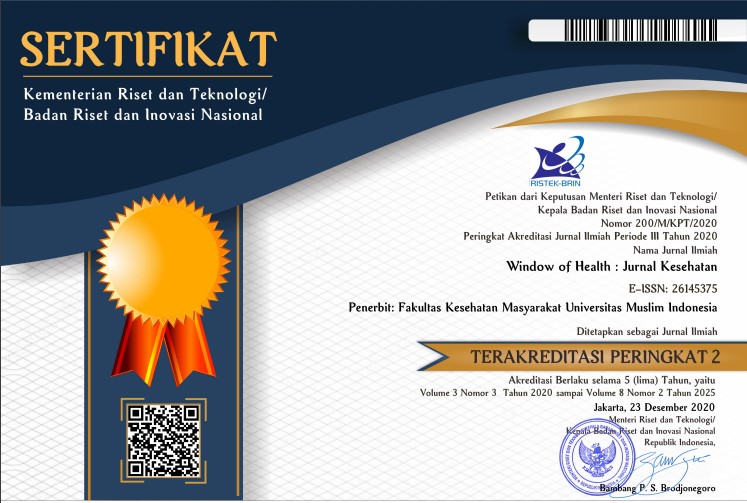Early Identification of HIV Infection Among Adolescents in Primary Care Center: A Case Study
Abstract
Adolescents are at high risk for HIV transmission due to exploratory behaviors and risky activities. Early identification of HIV infection is crucial to prevent transmission, as it interrupts the transmission chain through awareness of one's HIV status. This study aimed to explore the implementation of adolescent-centered HIV early detection services in primary care. A qualitative case study design was employed, involving in-depth interviews and document analysis at a public health center in Central Bandung. A purposively selected nurse, with 15 years of experience managing the HIV program, served as the key informant. Data were collected through semi-structured interviews and analyzed using content analysis techniques to identify key themes, categories, and codes. Six themes emerged: (1) VCT service procedures; (2) community health initiatives; (3) collaboration with external institutions; (4) adolescent engagement strategies; (5) barriers to adolescent testing; and (6) factors facilitating testing. Although the VCT protocol was comprehensive and included pre- and post-counseling, fear of a positive diagnosis. While the VCT model at the primary care level is aligned with national HIV prevention strategies, its effectiveness for adolescents is limited by low participation and social resistance. Integrating case-based learning in nursing education, enhancing peer-based outreach, and strengthening adolescent-friendly health services are recommended to improve early HIV detection and care linkage for youth.
References
Prabasari NA, Juwita L, Lyliana MA. Correlation Between Knowledge And Attitude To Prevent Transmission Of HIV/AIDS With Student’s Free Sex Behaviour. Nurs Curr J Keperawatan. 2019;6(2):55.
UNICEF. HIV/AIDS [Internet]. 2022 [cited 2024 Apr 27]. Available from: https://data.unicef.org/topic/gender/gender-and-hiv-aids/
IDAI. Data IDAI: 741 Remaja Tercatat Terinfeksi HIV Sepanjang 2022 [Internet]. 2022 [cited 2024 Apr 27]. Available from: https://news.republika.co.id/berita/rhmo0v349/data-idai-741-remaja-tercatat-terinfeksi-hiv-sepanjang-2022
Adebayo OW, Williams JR, Garcia A. A qualitative study of the decision‐making process of self‐initiated HIV testing among young adults. Res Nurs Health. 2020;43(2):186–94.
UNAIDS. 90-90-90: An ambitious treatment target to help end the AIDS epidemic [Internet]. 2021 [cited 2024 Apr 27]. Available from: https://www.unaids.org/en/resources/909090
Kemkes R. Cegah HIV-AIDS, Kemenkes Perluas Akses Pencegahan Pada Perempuan, Anak dan Remaja [Internet]. 2022 [cited 2024 Apr 27]. Available from: https://sehatnegeriku.kemkes.go.id
Kemenkumham R. Hadiri Debat Publik ‘Test HIV Pada Remaja’ [Internet]. 2022 [cited 2024 Apr 27]. Available from: https://jabar.kemenkumham.go.id
Puspitasari IM, Susanti D, Kusumawati E. Barriers to adolescent HIV testing in Indonesia: A mixed-method study. J Community Health Nurs. 2023;40(1):12–21.
Nall A, Chenneville T, Rodriguez LM, O’Brien JL. Factors affecting HIV testing among youth in Kenya. Int J Environ Res Public Health. 2019;16(8):1450.
Wahyuntari E, Ismarwati I. Pembentukan kader kesehatan posyandu remaja Bokoharjo Prambanan. J Inovasi Abdimas Kebidanan. 2020;1(1):14–8.
Kartikeyan S, Bharmal RN, Tiwari RP, Bisen PS. Voluntary Counselling and Testing Services. In: HIV and AIDS: Basic Elements and Priorities [Internet]. 2007 [cited 2024 Apr 27]. p. 313–21. Available from: https://www.researchgate.net/publication/314207150
Ramli R, Hidayati R, Hasanah U. Peran Perawat Sebagai Konselor VCT. Jurnal Ilmiah Kesehatan. 2022;13(2):112–7.
Fitriangga A, Pramana Y. Pengaruh Peran Perawat Sebagai Konselor Terhadap Respon Berduka Pasien HIV/AIDS. Jurnal Keperawatan Tanjungpura. 2021;10(1):34–9.
Setiawan NAP, Adi MS. Faktor Penghambat dalam Pelaksanaan Program VCT: A Literature Review. J Penelitian Kesehatan Suara Forikes. 2020;11(4):346.
Astari R, Fitriyani E. Pengaruh Peer Education Terhadap Pengetahuan Dan Sikap Remaja Tentang Pencegahan HIV-AIDS. J Ilmu Kesehatan Bhakti Husada. 2019;10(2):143–52.
Darmawan E, Purnamasari Y. Efektivitas Edukasi Kesehatan HIV/AIDS Melalui Media Audiovisual di Sekolah Menengah. J Kesehatan Masyarakat. 2020;15(3):214–20.
Kusumawati M, Hartini N. Evaluasi Program Sekolah Ramah Anak Dalam Pencegahan HIV. Jurnal Psikologi UGM. 2021;48(2):105–18.
Tri Handayani E, Arisona WL, Maryam S. Peningkatan Kesehatan Masyarakat melalui Deteksi Dini IMS dan HIV/AIDS dengan Metode VCT Mobile. JANITA. 2023;2(2):56–60.
Findi M. Peran Komunitas/LSM Dalam Pelaksanaan Bulan Viral Load HIV [Internet]. 2020 [cited 2024 Apr 27]. Available from: https://yki4tbc.org/ampuh-hiv-peran-komunitas-lsm-dalam-pelaksanaan-bulan-viral-load-hiv/
Kennedy CE, Medley AM, Sweat MD, O'Reilly KR. Behavioural interventions for HIV positive prevention in developing countries: a review. AIDS Behav. 2010;14(3):469–86.
Kohn JE, Hacker JG, Rousselle MA. Adolescent and young adult women’s assessment of a mobile-based sexual health intervention. J Adolesc Health. 2020;66(1):89–97.
Widman L, Noar SM, Choukas-Bradley S, Francis DB. Adolescent sexual health communication and condom use: A meta-analysis. Health Psychol. 2014;33(10):1113–24.
Copyright (c) 2025 Linlin Lindayani

This work is licensed under a Creative Commons Attribution-NonCommercial-ShareAlike 4.0 International License.








